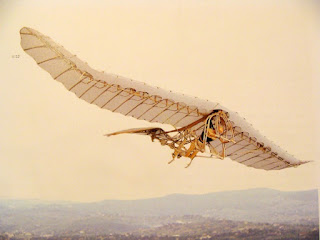Flying Machines and Sweet Dreams
Yes, the title is drawn from a line in a James Taylor song. No, it never thrilled me and is not about a plane crash. But we do want to dream — mayhaps a thought experiment — about designing something better.
We can draw inspiration from living things and also consider how humans built flying machines. Certain aspects of bird wings and bat wings are studied, as are those of dragonflies, for our own purposes. We cannot apply flapping to our device, we can glean principles from creatures.
 |
| Leonardo's ornithopter image credit: Flickr / James Wink (CC BY-ND 2.0) |
Let’s run a thought experiment to compare human design processes to creation. All design efforts start with a purpose. Say our goal is to build the world’s safest, most efficient 200-passenger aircraft capable of 7,000-mile nonstop flights, and money is no object.We’ll begin by recruiting the most talented and experienced aeronautical designers, pilots, engineers, machinists, technicians, and computer experts available. Only specific applicable skill sets will suffice.
To read the entire article, journey over to "Building a Perfectly Optimal Flying Machine".